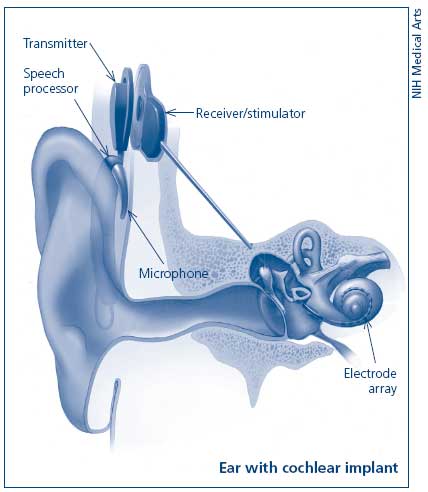Cochlear implants (CIs) are designed to help deaf adults and children who get little or no benefit from hearing aids. According to the National Institute on Deafness and Other Communication Disorders (NIDCD), in 2009 there were approximately 188,000 people in the world who received CIs. In United States, about 41,500 adults and over 25,500 children have a CI.
A CI is a surgically implanted electronic device that provides a sense of sound to a person who is profoundly deaf or hard of hearing. According to Advanced Bionics, a worldwide manufacturer of CIs, and NIDCD, a microphone picks up the sounds, which then go through the transmitter located behind the ear. The transmitter sends the sound through the receiver to the cohlea, which is located in the inner ear, to relay the incoming signal to the implanted electrodes. The electrodes are wired into the cochlea, which then sends the sound to the cochlear nerve that is connected to the brain.
Deaf people lack the hair cells in the ear that allow normal hearing. The hair cell is what helps the normal hearing people send sounds to the nerve then to the brain.
Despite the advantages, there is a lot of controversy over getting a CI in the deaf community. According to Mary Koch, an auditory education consultant who started the children's rehabilitation program at the Johns Hopkins' Listening Center, the medical world and the deaf world were split at the outset."The [deaf community's] perception is that there's nothing wrong [with being deaf]. There's nothing that needs to be fixed. Our perception is, there is something that needs to be fixed. So from the very foundation, we're diverging in our perspectives," Koch told CBS News in 1998.
The conflict in the deaf community is described as the use of manualism versus oralism. Manualism describes people who use sign language; oralism represents people who only talk and are not supposed to use sign language.
Those opposed to CIs have many reasons. Parents choose to give a child a CI; the child does not get to pick their mode of communication. A child with a CI would not need to sign anymore and some people fear that sign language will vanish. Others think deafness is not a disability, that it is a cultural identity.
Those who support implants think deaf people should be mainstreamed to the hearing world. People who support CIs believe that normalization is the key to success for deaf children. They believe refusing to implant deaf children is unethical when it can be effectively fixed.
According to Matt, a 18-year-old student with a CI, it is easier to have a CI because you can hear everything. It is easier to communicate with hearing people instead of using sign language, especially working on a job.
Michelle, who is a deaf adult without a CI, says sign language is extremely visual and can be improvised to add humor, imagination and personality. She feels it opens the door to communication access.
CIs will probably improve in the future. NIDCD is researching ways to improve the benefits provided by CIs by studying ways to make sounds clearer.

This work is licensed under a Creative Commons Attribution-NonCommercial-NoDerivs 3.0 Unported License














It gave me some info of what things a deaf person can get to help them to hear better! I liked it!
This information will really help a lot of people understand what they are seeing and some of the issues facing the deaf community. Thanks for sharing!
Informative article Casey!
I take ASL (American Sign Language) classes and my teacher is deaf. We got into a conversation about cochlear implants and one of the big issues were that it can irritate the ear at times. If an adult decided to get one then he/she can easily tell their doctor. However, a baby cannot tell anyone the implant is irritating his/her ear. I believe these implants should be a decision the deaf person makes his or herself. It is a personal choice in my view.
Is there monopoly in Cochlear Implant Business. Read more about the same at http://www.indiahearing.org.